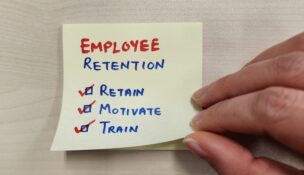Addressing Labor Challenges with AI and Automation — Where is the Line?
How AI and automation can help overcome labor challenges in Colorado's competitive market.
Jeff Smith //June 5, 2024//


Addressing Labor Challenges with AI and Automation — Where is the Line?
How AI and automation can help overcome labor challenges in Colorado's competitive market.
Jeff Smith //June 5, 2024//
Colorado business leaders still face persistent labor challenges in 2024.
Compared to other states, Colorado’s workforce trends younger and more educated than most, but we also have a gap between the availability of and demand for skilled workers. Automation is an attractive option for many employers to bridge that gap.
READ: Maximizing Efficiency, Minimizing Errors — Harnessing AI and Automation in Your Marketing Strategies
Automation can streamline work, ease labor challenges, create efficiencies and generate cost savings.
Improved accuracy that comes from automated systems can also help alleviate compliance/regulatory pressures, and improve productivity (e.g., reduced lead times or turn-around time), which is important in the current market given the shortage of skilled labor.
Examples of useful automation include robotic process (RPBA). RPBA bots can mimic human actions in digital systems like data entry to reduce manual effort and errors. In operations, AI-driven analytics can analyze datasets for insights and trends, helping businesses make data-driven decisions faster and with more accuracy.
Forward-thinking Colorado business leaders who want to stay competitive in today’s market should embrace automation, but consider these factors before you invest in these solutions.
Where will automation benefit your business?
These resources can be cheaper and more efficient, but they aren’t a direct replacement for human capital.
Look at automation and human capital as complementary resources — both are required for success and ideally, applied proportionately across your business.
To do so, think critically about aspects of your business that need humanized solutions (e.g., critical thinking, complex decision-making and judgments, social/emotional analysis, etc.) versus those where machine learning and automation could prove valuable.
Finance is an area that is ripe for investing in automation. Business owners can alleviate the burden of administration tasks surrounding accounting, tax and treasury functions, enabling employees to use their time and skills on other tasks, to develop their skills, and to take advantage of continuing education programs benefitting employees and employers.
READ: Exploring the Evolving Role of Accountants — Embracing Technology and Shaping the Future
For example, I recently oversaw the integration of an accounts payable optimization and automation system. We were seeing how inefficient it was for our team members to manually manage these tasks. We invested in automation tools and saw improvements in terms of financial control, data consistency and timeliness since completing the integration.
We reduced the amount of manual data entry required of team members, which has also helped eliminate missing invoices and other errors. The project resulted in over 75% time savings, and our employees have also been happy to reallocate that time to higher-priority tasks.
Pair automated and human resources for long-term ROI
It’s a good practice to find intersections like this where people and machines can complement each other. Beyond the transactional wins and cost-savings that automated practices create, workforce development should be included in the integration process.
When we automate tasks, our employees find themselves with more time on their hands.
It’s important to direct them to areas where they should spend that time to create long-term value. From a finance perspective, you bank the cost savings created by automated processes and take it a step further to improve ROI by reinvesting time saved back into your workforce development goals.
READ: AI vs. Traditional — Which is the Best Approach in Recruitment
4 steps to effectively implement automated processes
- Research the areas of business that are ripe for automation: Focus on profitability measures and ROI potential. Consider how much human judgment is required for success. Integrate automation with the intention to protect and preserve the human elements of your business that promote culture and create their own value.
- Establish benchmarks and quantify the value created by automation: Test and monitor outcomes to ensure implemented solutions deliver a return within an appropriate timeframe.
- Communicate expectations when it comes to desired outcomes driven by automated solutions: If you remove the human element from the work, the people behind those tasks need to know where to reallocate their time and effort.
- Re-evaluate automated processes based on measured outcomes: Continuously improve processes to optimize those outcomes.
Strike a balance to avoid pitfalls
Although advancements in automation offer ample opportunity to streamline work and improve profitability, be mindful of pitfalls they present, which can threaten your business.
If you don’t give clear direction as to where employees should reallocate their time after automating a task, employees may feel undervalued and replaceable. As a business leader, your job is to ensure that real, live people always have a place at work; they are the life force of corporate culture, which is an important asset on its own. Don’t lean in so far on automation that you alienate employees and risk depreciating the value of your corporate culture.
Instead, use automation to enhance your company and create more value by integrating it with workforce development goals. Doing so will help your business capitalize on opportunities in a competitive landscape and demonstrate to current and prospective employees that their contributions are still vital to succeed.
Jeff Smith is the CFO of Kodiak Building Partners. He brings an entrepreneurial mindset to his role and oversees finance, accounting, treasury, mergers and acquisitions, and capital formation for Kodiak and its operating partners, including dozens of companies within the building materials industry.
T

























